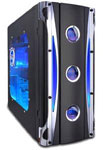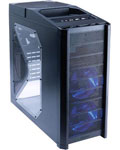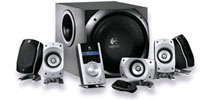Displays, Cases and Peripherals
| Base High-End Case and Accessories |
| Hardware |
Component |
Price |
Rebates |
| Display |
Acer AL2216Wbd 22" 5ms 1680x1050 |
$250 |
- |
| Case |
Apevia Aspire X-Cruiser |
$59 |
- |
| Power Supply |
Corsair CMPSU-620HX |
$126 |
- |
| Keyboard and Mouse |
Microsoft Comfort Curve 2000 with Optical Mouse |
$28 |
- |
| Speakers |
Creative I-Trigue 3300 |
$73 |
- |
| Total |
$536 |
$536 |
The monitor chosen as a minimum for the high-range systems is the
Acer AL2216Wbd. The 22" display has a 5ms response time and a resolution of 1680x1050, and while our review found that it wasn't competitive in terms of overall quality with most of the 24" LCDs, it's hard to argue with the significantly lower price. Regular readers of the Guide section of AnandTech will recognize this monitor as a frequent selection during the past few guides, and also notice that the price has dropped significantly on this model.
 |
Apevia is generally known as a component-brander, rather than a manufacturer, whose products typically target the value segment. The Aspire X-Cruiser case is, accordingly, a steel case, but it has lots of interesting embellishments. The clear side window, fan speed controller, fan speed indicator, and blue LEDs provide a lot of value compared to more well-known cases. Airflow is handled by two 80mm fans. Depending on your personal tastes, you may or may not like this case, but there are plenty of people that simply view the case as something to hold the rest of the components and for such users the Aspire X-Cruiser is a nice fit. Note that this case is an entry-level recommendation - if you are targeting this segment, you have more than ample choices to ensure that you get one that fits your needs.
The Corsair CMPSU-620HX is a solid offering from a company long known for providing excellent power supplies. Claiming an 80% efficiency rating and sporting three 12V rails rated at 18A, this power supply handles all hardware recommended in this Guide without issue at stock speeds. Overclockers (especially on quad core systems) and water-coolers, however, should look to the larger PSU offerings to ensure system stability. Airflow is provided by a bottom-mount 120mm fan. The Corsair power supplies are rebranded SeaSonic units, so if you prefer a SeaSonic S12 (or can find it for less money) the two are essentially the same.
 |
For the entry level speaker selection, we turn to Creative Labs. Creative's products run the gamut from entry-level to enthusiast, with a focus on PC gaming. The C44-6004, while not quite the pinnacle of Creative's effort, provides gamers with a solid audio environment, especially at the given price point. The Creative features entry-level 7.1 sound. Logitech's X-530 and X-540 are as usual viable alternatives in this price bracket. Any speakers selling for under $100 are definitely more midrange rather than high-end, but for a lot of people that's more than enough.
| Mainstream High-End Case and Accessories |
| Hardware |
Component |
Price |
Rebates |
| Display |
Dell UltraSharp 2407WFP |
$569 |
- |
| Case |
Antec Nine Hundred |
$115 |
- |
| Power Supply |
PC Power Silencer 750 Quad |
$200 |
- |
| Keyboard and Mouse |
Microsoft Natural Keyboard and 5000 Optical Mouse |
$61 |
- |
| Speakers |
Logitech Z-5300e |
$145 |
- |
| Total |
$1090 |
$1090 |
Most users either love or hate the Antec Nine Hundred case. The appearance of this steel mid-tower offering is something that has yet to be imitated by a competitor (draw what conclusions you will), but it's impossible to argue against this being a hardcore case. Four fans, including a 200mm behemoth at the top, ensure that airflow is more than adequate for even the most demanding of components. USB, FireWire, and audio ports for the case sit at the top, which makes a lot of sense, given that cases are usually on the floor.
An upgraded high-end solution deserves a larger display, and the Dell UltraSharp 2407WFP fills the need. Staying true to its name, Dell offers this 1920x1200 panel with virtually the same specifications as competing designs from Samsung (
244T) and others, but at a significantly lower price point. The 3 year warranty seals the deal.
The power supply also gets an upgrade for this package, making a fairly large jump up to the PC Power Silencer 750 Quad. This power supply is built to perform, with the capability of delivering a full 60A on its single 12V rail. At $195, it is a premium level component to be sure - but at this level, the additional cash outlay eliminates any concerns of power instability in our high-end system. The inclusion of four PCI-E 6-pin power adapters will definitely work well with the SLI 8800 GTX configurations.
Finally, the sound system makes the jump into the land of THX, with the Logitech Z-5300e package. The silver accents on the speakers are themselves another example of styling which provokes either a love-or-hate reaction; however, the sound quality from the system (particularly the subwoofer) places the audio aspect of these components squarely into the "enthusiast" category.
| Ultra High-End Case and Accessories |
| Hardware |
Component |
Price |
Rebates |
| Display |
Samsung 305T 30" 2560x1600 |
$1331 |
- |
| Case |
Kandalf VD4000BWS Liquid Cooled |
$270 |
- |
| Power Supply |
OCZ POWER GAMER OCZ1010GXSSLI |
$251 |
- |
| Keyboard and Mouse |
Logitech G15 Gaming Keyboard and G5 Mouse |
$110 |
- |
| Speakers |
Logitech Z-5500 |
$233 |
- |
| Total |
$2195 |
$2195 |
Yes, the
Dell 30" 3007WFP usually can be found for a little bit less than the Samsung 305T in the Ultra High-End selection; however, the newer 3007WFP-HC costs a bit more. The Samsung 305T panel therefore gets the nod for the display device on our $5000 rig, as you also get two dual-link DVI inputs whereas the Dell LCDs only include one. Like all current 30" panels, this display features a native 2560x1600 resolution; every ounce of horsepower in our 8800 GTS/GTX SLI configurations will be put to the test. For those interested in the improved color gamut of the newer Dell LCD, we would also suggest taking a look at the
HP LP3065, which offers the same improved color gamut but also includes three dual-link DVI ports.
At the extreme end of the spectrum, a case with built-in liquid cooling makes a lot of sense, and the Thermaltake Kandalf is an excellent way to go. The VD4000BWS is a truly amazing case, with three 120mm fans and blue LEDs complementing the aforementioned liquid cooling. This case is a monster, with nine 5.25" bays and eight 3.5" bays (two external) housing whatever components a user could dream of throwing in. Considering many water-cooling solutions can cost several hundred dollars, the overall price of this case plus water-cooling kit is very attractive. If you would prefer to avoid water cooling altogether, the Cooler Master 830CM Stacker case is a strong alternative.
The power supply for the system gets another nudge to the OCZ Power Gamer 1010GXSSLI. Going a couple notches further than the PC Power unit, the 1010GXSLI sports four 20A 12V rails, which is enough to handle even the water-cooled SLI setup chosen for the most expensive systems in this Guide.
For those of us with $5000 (okay, $5328) to spend, the Logitech Z-5500 Digital system is the only way to go. A powerful subwoofer placed only a few feet from a gamer can't be anything but good, and you'll be hard pressed to resist playing with that LCD control panel. The total sound volume is impressive given the price, and only much more expensive (and larger) home theater equipment will really put these speakers to shame. You don't necessarily need speakers this loud... but you know you want it.
















69 Comments
View All Comments
CK804 - Tuesday, May 29, 2007 - link
A lot of sites seem to prove you wrong in addition to the ones I linked to. You need to get your meter checked or that Dell PS is REALLY inefficient. All of these sites measure power drawn by the SYSTEM at the AC outlet. None of the 8800GTX SLI configurations use more than 500 watts under full load and the R600 Crossfire setup uses 522 watts under full load.http://www.pcper.com/article.php?aid=332&type=...">One.
http://techreport.com/reviews/2007q1/geforce-8800-...">Two.
http://www.bit-tech.net/hardware/2007/05/16/r600_a...">Three.
http://www.hwupgrade.com/articles/video/13/the-nvi...">Four.
http://www.anandtech.com/video/showdoc.aspx?i=2873...">Now check this out from YOUR OWN SITE. Do you really think that an upgrade to a quad core and another 8800GTX will pull another 500 watts?
JarredWalton - Wednesday, May 30, 2007 - link
The big question is whether or not you plan on overclocking. I just did some quick tests, and taking a quad core QX6700 chip from 2.67 GHz to 3.33 GHz increases the power draw by about 60W. I know that if I went out and got a QX6700, I would overclock it at least that far. For that matter, if I got a Q6600, I would probably shoot for a similar clock speed.At stock voltage, stock speeds, the highest power draw I got with CrossFire X1950 XTX and a QX6700 (with three hard drives in the system) was "only" 488W. Could such a system run with a 520W power supply? Perhaps, provided it's a really high-quality power supply. Personally, I like to have a bit of leeway, so I would say 620W minimum for such a configuration.
Looking at your Bit-tech link, it appears that a Radeon HD 2900 XT consumes ~70W more power than a Radeon X1950 XTX, and in CrossFire mode the difference was 145W (worst-case). 488W + 145W = 633W... Eureka! Now, are you still going to want to run such a configuration with a 620W power supply? You could try, and it might even work depending on how often you reach maximum load, but again I prefer a little leeway. Without overclocking, I can easily see quad core and 2900 XT CrossFire breaking 600W on a regular basis (or at least approaching it). Throw in overclocking (~80W) and water-cooling (10W-30W - or more - depending on pump), and we are now at over 700W. Sure enough, that's exactly what I measured with the Dell XPS 720H2C (add a few more watts for the additional memory).
I personally follow an 80% rule: just to be safe, I don't exceed 80% of the rated power supply wattage. (this is especially important if you have power supplies with multiple 12V rails, as you almost certainly won't be drawing maximum power from each rail.) That means if I'm going to be drying up to 600W of power, I would want at least at a 750W power supply. If I'm going to overclock, I would want something in the 850W+ range.
CK804 - Wednesday, June 27, 2007 - link
http://www.silentpcreview.com/forums/viewtopic.php...">It seems that the TEC inside your Dell is drawing a lot of power. That's why your power consumption is so high. A power supply wattage rating is the amount of power that the PS can deliver to the components and not how much power it can draw from the wall. Since we have to account for efficiency, 800W * 0.8 = 640 is the power consumption of the components inside. Take away the power consumption of the TEC (640 - 120) and the power consumption of the components is about 520 watts.CK804 - Tuesday, May 29, 2007 - link
http://www.theinquirer.net/default.aspx?article=36...">Are you sure about that breaking 850 watts?http://www.abxzone.com/forums/cases-psus-mods/1064...">That's a little too extreme, don't you think?
JarredWalton - Tuesday, May 29, 2007 - link
Depends on what you throw in there. I've got a system with an overclocked QX6700 and 8800 Ultra SLI with water-cooling, multiple hard drives, and basically about every high-end option you can find. I've measured peak power draw of nearly 800W, and a stock HD 2900 XT uses more power than an 8800 GTX by about 20W at load. Overclock two of those cards, and yes I think you can break 850W power draw.FWIW, idle power draw is 475W on the system, putting 100% load on the CPU takes that up to 625W, and 100% CPU while running 3DMark06 put it at something close to 750-775W (with the average being more like 700W). If I were to manually overclock the GPUs, then I'm sure I could break 800W.
CK804 - Tuesday, May 29, 2007 - link
I still call BS on 800. 475 watts idling? That's a little too extreme don't you think? Did you even read the sites I linked to? And what are you measuring with? Your @SS?JarredWalton - Tuesday, May 29, 2007 - link
Some people always need proof I suppose.Sitting next to me is a Dell XPS 720 H2C measured at the outlet with a Kill-A-Watt device. The CPU is running at 3.43 GHz with 1.550V. Why should I need to read your links when I've got a system right in front of me generating those numbers? But of course you're right: your linked article must be more accurate than anything we could measure in-house. The Dell has a 1000W power supply, and I'm sure Dell is just being cautious, like they are with their 375W PSUs in the XPS 410.
PS: My ass measured a power output of 1.21GW last I checked. I have to be careful as I don't want to accidentally warp myself through time if I go eat Mexican food. You see, I also have a flux capacitor hardwired into my spine, just in case....
Thanks for reading, though.
CK804 - Tuesday, May 29, 2007 - link
http://www.xbitlabs.com/articles/other/display/100...">AMD 4x4 system with 8800GTX SLI uses 612 watts under full load.JarredWalton - Tuesday, May 29, 2007 - link
Overclocking + overvolting will jack up the power draw of the CPU quite a bit. Stock voltage is supposed to be 1.300V (I think) and overclocked it's 1.550V, plus it's running at 3.43 GHz instead of 2.67 GHz. Throw in a water-cooling setup, three hard drives, 4GB RAM, and you get quite a bit more power draw than a stock 4x4 SLI setup.CK804 - Tuesday, May 29, 2007 - link
Hard drives draw about 10 watts each. That's 30 watts. Each extra memory module will draw about 5 more watts. That's 20 watts. The water pump should draw no more than 10 watts and the fans about 5 watts each. Assuming you're using 2 120mm fans, the extra power draw under a worse case secenario would be 90 watts. So now we move onto the CPU. Are you seriously going to tell me that an overclocked Core 2 Quad consumes 300 watts under load? A Smithfield barely consumed half of 300 watts. I think any CPU would explode if it consumed 300 watts.